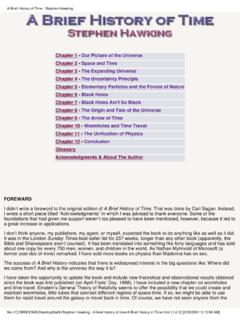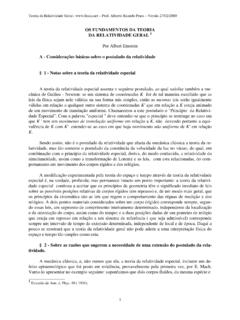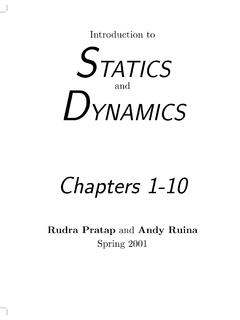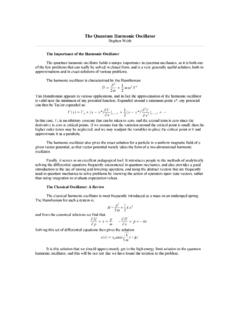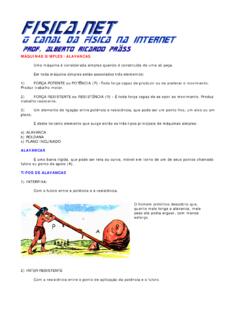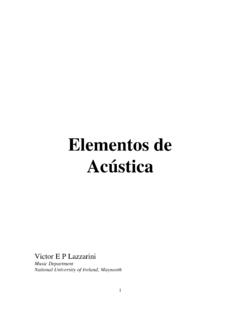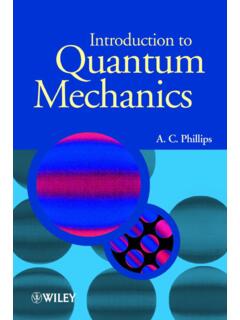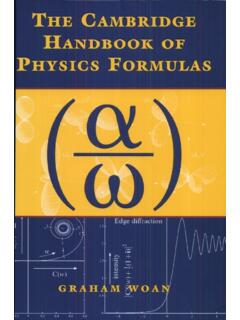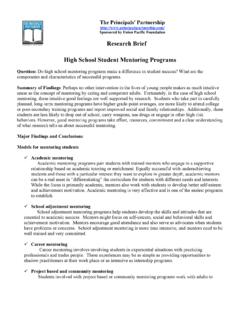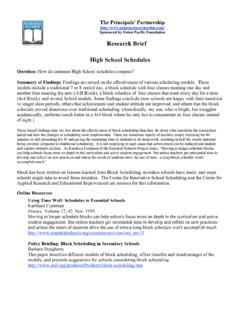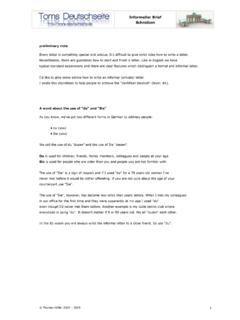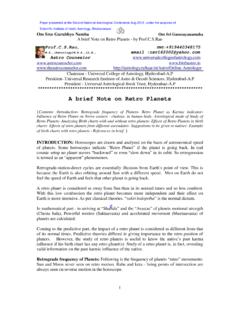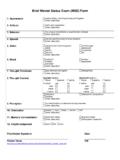Transcription of A Brief History of Time - Stephen Hawking - www.fisica.net
1 A Brief History of time - Stephen Hawking Chapter 1 - Our Picture of the Universe Chapter 2 - Space and time Chapter 3 - The Expanding Universe Chapter 4 - The Uncertainty Principle Chapter 5 - Elementary Particles and the Forces of Nature Chapter 6 - Black Holes Chapter 7 - Black Holes Ain't So Black Chapter 8 - The Origin and Fate of the Universe Chapter 9 - The Arrow of time Chapter 10 - Wormholes and time Travel Chapter 11 - The Unification of Physics Chapter 12 - Conclusion Glossary Acknowledgments & About The Author FOREWARD. I didn't write a foreword to the original edition of A Brief History of time . That was done by Carl Sagan. Instead, I wrote a short piece titled Acknowledgments in which I was advised to thank everyone. Some of the foundations that had given me support weren't too pleased to have been mentioned, however, because it led to a great increase in applications. I don't think anyone, my publishers, my agent, or myself, expected the book to do anything like as well as it did.
2 It was in the London Sunday Times best-seller list for 237 weeks, longer than any other book (apparently, the Bible and Shakespeare aren't counted). It has been translated into something like forty languages and has sold about one copy for every 750 men, women, and children in the world. As Nathan Myhrvold of Microsoft (a former post-doc of mine) remarked: I have sold more books on physics than Madonna has on sex. The success of A Brief History indicates that there is widespread interest in the big questions like: Where did we come from? And why is the universe the way it is? I have taken the opportunity to update the book and include new theoretical and observational results obtained since the book was first published (on April Fools' Day, 1988). I have included a new chapter on wormholes and time travel. Einstein's General Theory of Relativity seems to offer the possibility that we could create and maintain wormholes, little tubes that connect different regions of space- time .
3 If so, we might be able to use them for rapid travel around the galaxy or travel back in time . Of course, we have not seen anyone from the file:///C|/WINDOWS/Desktop/blahh/ Stephen Hawking - A Brief History of time /A Brief History in (1 of 2) [2/20/2001 3:13:58 AM]. A Brief History of time - Stephen Hawking future (or have we?) but I discuss a possible explanation for this. I also describe the progress that has been made recently in finding dualities or correspondences between apparently different theories of physics. These correspondences are a strong indication that there is a complete unified theory of physics, but they also suggest that it may not be possible to express this theory in a single fundamental formulation. Instead, we may have to use different reflections of the underlying theory in different situations. It might be like our being unable to represent the surface of the earth on a single map and having to use different maps in different regions. This would be a revolution in our view of the unification of the laws of science but it would not change the most important point: that the universe is governed by a set of rational laws that we can discover and understand.
4 On the observational side, by far the most important development has been the measurement of fluctuations in the cosmic microwave background radiation by COBE (the Cosmic Background Explorer satellite) and other collaborations. These fluctuations are the finger-prints of creation, tiny initial irregularities in the otherwise smooth and uniform early universe that later grew into galaxies, stars, and all the structures we see around us. Their form agrees with the predictions of the proposal that the universe has no boundaries or edges in the imaginary time direction; but further observations will be necessary to distinguish this proposal from other possible explanations for the fluctuations in the background. However, within a few years we should know whether we can believe that we live in a universe that is completely self-contained and without beginning or end. Stephen Hawking file:///C|/WINDOWS/Desktop/blahh/ Stephen Hawking - A Brief History of time /A Brief History in (2 of 2) [2/20/2001 3:13:58 AM].
5 A Brief History of time - Stephen Chapter 1. CHAPTER 1. OUR PICTURE OF THE UNIVERSE. A well-known scientist (some say it was Bertrand Russell) once gave a public lecture on astronomy. He described how the earth orbits around the sun and how the sun, in turn, orbits around the center of a vast collection of stars called our galaxy. At the end of the lecture, a little old lady at the back of the room got up and said: What you have told us is rubbish. The world is really a flat plate supported on the back of a giant tortoise. The scientist gave a superior smile before replying, What is the tortoise standing on. You're very clever, young man, very clever, said the old lady. But it's turtles all the way down! . Most people would find the picture of our universe as an infinite tower of tortoises rather ridiculous, but why do we think we know better? What do we know about the universe, and how do we know it? Where did the universe come from, and where is it going? Did the universe have a beginning, and if so, what happened before then?
6 What is the nature of time ? Will it ever come to an end? Can we go back in time ? Recent breakthroughs in physics, made possible in part by fantastic new technologies, suggest answers to some of these longstanding questions. Someday these answers may seem as obvious to us as the earth orbiting the sun or perhaps as ridiculous as a tower of tortoises. Only time (whatever that may be) will tell. As long ago as 340 BC the Greek philosopher Aristotle, in his book On the Heavens, was able to put forward two good arguments for believing that the earth was a round sphere rather than a Hat plate. First, he realized that eclipses of the moon were caused by the earth coming between the sun and the moon. The earth's shadow on the moon was always round, which would be true only if the earth was spherical. If the earth had been a flat disk, the shadow would have been elongated and elliptical, unless the eclipse always occurred at a time when the sun was directly under the center of the disk.
7 Second, the Greeks knew from their travels that the North Star appeared lower in the sky when viewed in the south than it did in more northerly regions. (Since the North Star lies over the North Pole, it appears to be directly above an observer at the North Pole, but to someone looking from the equator, it appears to lie just at the horizon. From the difference in the apparent position of the North Star in Egypt and Greece, Aristotle even quoted an estimate that the distance around the earth was 400,000 stadia. It is not known exactly what length a stadium was, but it may have been about 200. yards, which would make Aristotle's estimate about twice the currently accepted figure. The Greeks even had a third argument that the earth must be round, for why else does one first see the sails of a ship coming over the horizon, and only later see the hull? Aristotle thought the earth was stationary and that the sun, the moon, the planets, and the stars moved in circular orbits about the earth.)
8 He believed this because he felt, for mystical reasons, that the earth was the center of the universe, and that circular motion was the most perfect. This idea was elaborated by Ptolemy in the second century AD into a complete cosmological model. The earth stood at the center, surrounded by eight spheres that carried the moon, the sun, the stars, and the five planets known at the time , Mercury, Venus, Mars, Jupiter, and Saturn. file:///C|/WINDOWS/Desktop/blahh/ Stephen Hawking - A Brief History of (1 of 7) [2/20/2001 3:14:06 AM]. A Brief History of time - Stephen Chapter 1. Figure 1:1. The planets themselves moved on smaller circles attached to their respective spheres in order to account for their rather complicated observed paths in the sky. The outermost sphere carried the so-called fixed stars, which always stay in the same positions relative to each other but which rotate together across the sky. What lay beyond the last sphere was never made very clear, but it certainly was not part of mankind's observable universe.
9 Ptolemy's model provided a reasonably accurate system for predicting the positions of heavenly bodies in the sky. But in order to predict these positions correctly, Ptolemy had to make an assumption that the moon followed a path that sometimes brought it twice as close to the earth as at other times. And that meant that the moon ought sometimes to appear twice as big as at other times! Ptolemy recognized this flaw, but nevertheless his model was generally, although not universally, accepted. It was adopted by the Christian church as the picture of the universe that was in accordance with Scripture, for it had the great advantage that it left lots of room outside the sphere of fixed stars for heaven and hell. A simpler model, however, was proposed in 1514 by a Polish priest, Nicholas Copernicus. (At first, perhaps for fear of being branded a heretic by his church, Copernicus circulated his model anonymously.) His idea was that the sun was stationary at the center and that the earth and the planets moved in circular orbits around the sun.
10 Nearly a century passed before this idea was taken seriously. Then two astronomers the German, Johannes file:///C|/WINDOWS/Desktop/blahh/ Stephen Hawking - A Brief History of (2 of 7) [2/20/2001 3:14:06 AM]. A Brief History of time - Stephen Chapter 1. Kepler, and the Italian, Galileo Galilei started publicly to support the Copernican theory, despite the fact that the orbits it predicted did not quite match the ones observed. The death blow to the Aristotelian/Ptolemaic theory came in 1609. In that year, Galileo started observing the night sky with a telescope, which had just been invented. When he looked at the planet Jupiter, Galileo found that it was accompanied by several small satellites or moons that orbited around it. This implied that everything did not have to orbit directly around the earth, as Aristotle and Ptolemy had thought. (It was, of course, still possible to believe that the earth was stationary at the center of the universe and that the moons of Jupiter moved on extremely complicated paths around the earth, giving the appearance that they orbited Jupiter.)
